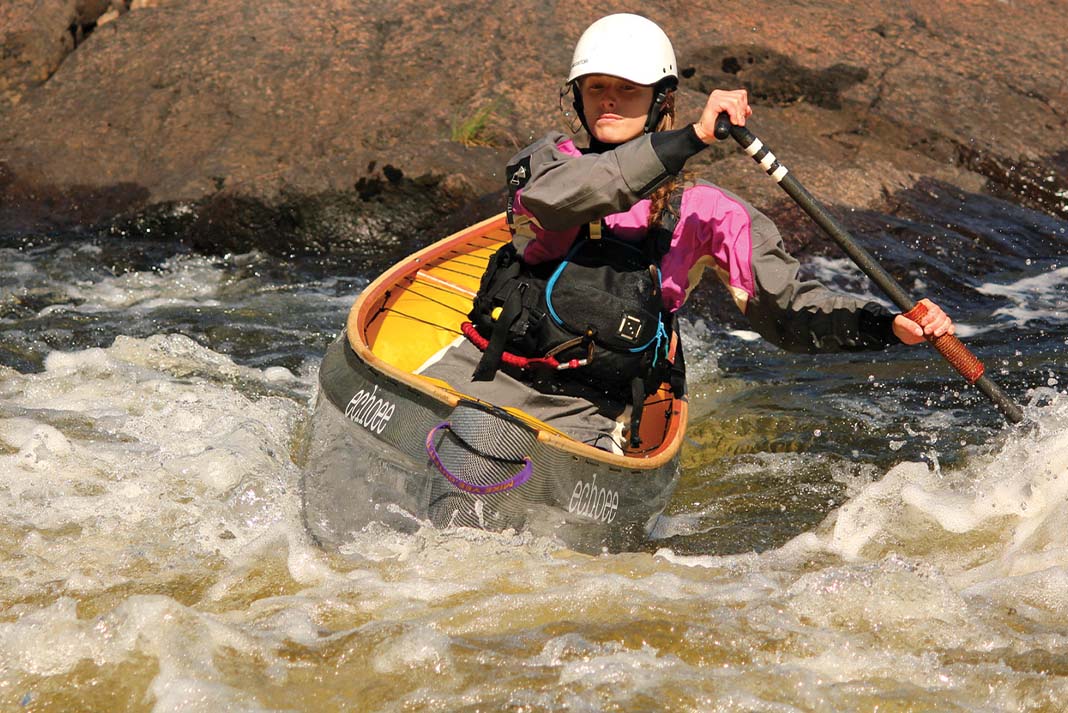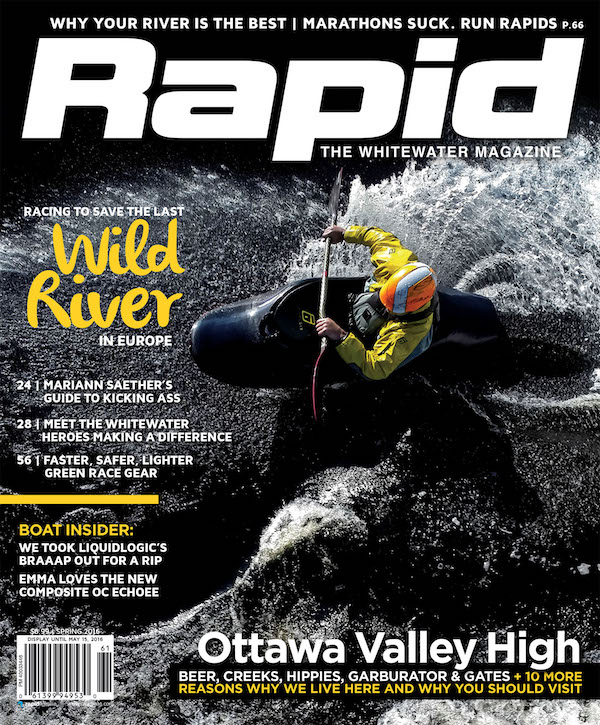I am sitting in my boat clenching my fists and shivering. It’s a rainy May afternoon, a week into a 10-day solo canoe instructor course. Lined up in the eddy, we watch as our instructor, Andy Convery, demonstrates a flawless carving front surf. It’s irritating—everything he does looks effortless while my own moves feel like a slog.
Flash forward six years, and I’m paddling the Echoee, a brand new boat built by Convery himself. Within minutes on the water in the new boat, I feel like the canoeist I’ve spent half a decade trying to become—fluid, strong, graceful.
It’s not just my time and practice that has made the difference: Barely tipping the scales at a mindboggling mere 28 pounds fully outfitted, the Echoee paddles like a feather.
Every stroke is powerful, like I’m pulling myself over the water instead of dragging my boat through it.
I achieve momentum with next-to-no effort. A single stroke accelerates the Echoee to speed, and the energy saved lets me flick around the river for hours of fun.
“Who has designed all our equipment? Big burly men. ‘I’m big and strong, what do I care if my boat is big and clunky?’” says Convery, describing the problem with boat building. “By scaling it down, everyone wins.”
With the 18-pound hull and 10 pounds of saddle, thwarts, straps and gunwales, plus my weight of 130, the Echoee and I weigh a grand total of 158. It makes for a rodeo-like experience when I first hit larger features—there simply isn’t enough mass for me to plow through a hole like I might have done in a heavier hull. It is, however, easier than ever to control where I end up in relation to each feature, and finessing my way on and off waves, over and around holes, and slicing across currents and eddylines feels like a ballroom dance between me and the river.
The Echoee demands to be paddled. On entry to a rapid where I’d normally line myself up, float to the sweet spot and then lay on the power, I get pulled around by little boils and currents during the “float” phase. I need to be active to keep this boat on line and it takes amazingly little effort to do so.
While the rest of the canoeing world has been in a tizzy over the so-called Royalex Crisis, Convery believes it’s a huge step forward in the evolution of paddling.
“The perception is that lightweight equals fragility, and it’s going to change the way we paddle,” he says. It’s true: There is something about being in a composite boat; I was more intentional than ever about where in the rapid I wanted my boat, and I could put it there with unprecedented ease. “We won’t just toboggan our way down rocky rivers like we used to,” Convery adds.
I know what you’re thinking, though—what if?
When I do smash rocks, the Echoee can handle it. Seriously. I wasn’t so sure at first either. When I picked it up to put on my car—a task that until now, I had to pretend was easy—it almost felt too light to trust on a whitewater run. But besides some superficial scratches on the outer Innegra-basalt layer, I couldn’t hurt it.

“I’ve put this thing through hell trying to figure out what the breaking point is. I’ve been approaching rapids looking for the class IV rock line that I’d never even take my Royalex boats down,” says Convery. “I’ve been astonished.”
It’s not that he didn’t put wear and tear on his prototypes. In fact, beating the crap out of them is how he landed on the ideal layup. Here’s the nitty gritty: three layers throughout the whole hull using carbon, Kevlar and Innegra-basalt, plus two extra layers in the chine at the bow and stern for tough, built-in skid plates of Kevlar and Innegra-basalt, and a foam core and another layer of fiberglass in the bottom.
If repairs are ever needed, Convery is standing by his product. “Bring it back anytime in the first year and I’ll repair it for free,” he says.
As the founder and craftsman of Quebec-based Echo Paddles, Convery has been working with these materials for 20 years. He says infinite repairability is a huge advantage of composites— you can fix them with the same materials they’re made from.
The Echoee has the dimensions of Frankie Hubbard’s original 1996 Dagger Ocoee, arguably the most popular solo canoe of all time. Flat-bottomed and hard-chined, it is unbelievably maneuverable. When I get the outfitting just right in Echo’s lightweight version, I can turn the boat one way or the other just by aiming my hips, like it’s an extension of my lower body floating on the water. But you don’t have to take my word for it: Convery debuted the boat at the 2015 Gull River Open Canoe Slalom Race, where it took all three top finishers to the podium.
ECHOEE SPECS
Length: 11’2″
Width: 25″
Depth: 16″
Weight, Raw Hull: 18 lbs
With Gunwales and Outfitting: 28 lbs
Price, with Wood Gunwales: $2,100
With Gunwales and Outfitting: $2,550
echopaddles.com
 This article originally appeared in Rapid Spring 2016 issue.
This article originally appeared in Rapid Spring 2016 issue.
Subscribe to Paddling Magazine and get 25 years of digital magazine archives including our legacy titles: Rapid, Adventure Kayak and Canoeroots.




